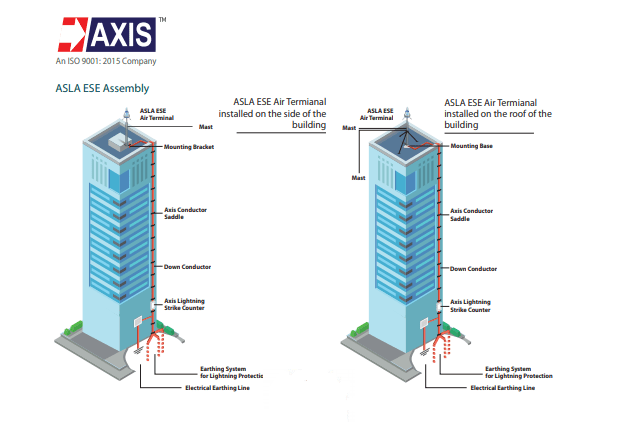Lightning – a natural phenomenon as breathtaking as it is deadly. It’s a spark that bridges the gap between negatively and positively charged sections of a cloud, and its power can cause significant damage, especially to tall buildings. However, thanks to modern engineering, we have a defence mechanism against this powerful force of nature – the lightning conductor. In this blog, we’ll explore what are lightning conductors, how they work, and why they’re so crucial for the safety of our structures.

What are Lightning Conductors?
A metal rod placed on top of a building to protect it from a lightning strike is known as a Lightning Conductor.
This conductor is struck first in lightning without hitting the building directly, preventing fire or electrocution. It provides a harmless and easy path for the lightning energy to pass into the ground without damaging the structure of the buildings. The “path” or the earthing system is installed from the top to the bottom of the building. The conductor provides a poor resistance path between the top of the conductor rod – through a substantial metal strip – to the ground. Hence the current from the lightning strike is diverted through the rod and avoids flowing through the building.
How Does a Lightning Conductor Work?
The lightning conductor works on the principle of induction. When a fully charged cloud passes by the building, the conductor gets charged oppositely through induction and this acquired charge moves to the earth through the earthing system. The electrical length of its rod will always be greater than its physical length. The air becomes a conductor in the presence of a large electric field, and this electric field is strong around sharp objects than objects where the surface is flatter.
During the build-up of lightning, charges are induced at the top of the pointed lightning conductor rod by the cloud charge. The effective length of the conducting path of the conductor gets extended as the induced charge is sufficiently large and the air around the point of the lightning conductor acts as a conducting medium. Recent lightning conductors are slightly rounded because the electric field created by a charged round point conductor is smaller when compared to a sharp point. Hence, the air conducting cover a greater distance above the lightning conductor rod. The ionization of air around a lightning conductor rod then allows the lightning to strike more randomly.
Lightning conductors can also be called lightning rods, finials, air terminals, or strike termination devices. They are available in different types like hollow type, solid, pointed, rounded, flat strips or bristle brush-like. The main feature of a lightning rod is that the materials used to make the conductor are conductive materials such as copper and aluminium. Generally, copper and its alloys are used while manufacturing lightning protection devices. The core advantage of a lightning conductor rod is to make the air around it a conductor and contribute to the discharge of clouds. Contribute without the lightning being produced and minimize the risk (chances of a lightning strike). Many devices need protection from external damages such as step potential, touch potential etc.
The highly charged clouds are charged with high-density ionized electrons on the outer layer, which induces an opposite charge around the lightning conductor and is nearly equal to the potential present in the cloud. This phenomenon attracts the lightning towards accumulated opposite charges around the conductor, creating a virtual path for the lightning to drain out of the high potential electric charge along the conductor. The lightning rod is placed on the top-most corner, where the lightning rod is mounted on a mounting base and connected to an earthing rod or a ground rod through a copper cable. The lightning absorbed by the lightning rod is diverted through this path by avoiding any damage to the structure.
Watch our video to understand the working of a conductor in detail!
Conclusion
The sole purpose of a lightning conductor is to offer a low resistance path to the lightning and allow it to pass through the ground without impacting the physical structure. Protection from lightning is essential to safeguard humans, transmission lines and electrical equipment by controlling different types of risks from thermal, mechanical and electrical hazards of the lightning flash current. Lightning always finds a way to flow through the best conductor and flow through it where the medium might be a tree or a building. When the fully charged cloud passes over the lightning conductor, the electric charge will flow down until the cloud is fully discharged. Therefore, there will not be any flash or sound of thunder during this process.
Thank you for reading the blog, Axis is a leading manufacturer and supplier of Electrical Components to over 80+ Countries. To get a quote or to talk to our industry expert visit our contact us section. You can also watch our videos by our experts – click here.










